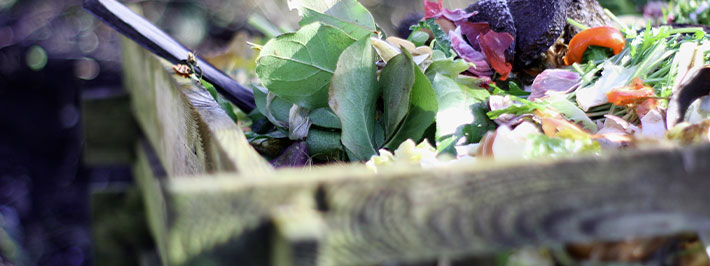
Prepare my compost: how do I do it?
The classification of your bio-waste for composting allows to obtain a compost with high added value. A simple eco-responsible approach, even in an apartment.
Fruit and vegetable peels, coffee grounds, tea bags, food scraps, grass clippings, dead leaves, hedge and shrub clippings, at home and in the garden we produce a large amount of organic waste. So much so that they represent 40 to 60% of the garbage in our home. Composting allows them to be recycled and recovered, to the greater benefit of the environment. A good way to improve the fertility of the soil in our gardens or in our potted plants, without chemicals.
A natural process
In the presence of oxygen and water, the material that is placed in the compost bin is first broken down by microorganisms, bacteria, and fungi. Then worms, mites, and other insects take over. At the end of the process, that is to say from nine to twelve months, we obtain the precious compost, a homemade potting soil that smells of humus and that is ideal for flowers, plants, orchards, shared green spaces. Mixed with soil and spread in thin layers on the soil, it considerably improves its qualities of porosity and resistance to erosion. And it stimulates the growth of plants.
Waste to be used systematically
Kitchen waste such as husks, coffee, bread, dairy products, cheese rinds, vegetable tops, etc., can be systematically sent to the composter. Like yard waste, grass clippings, dead leaves, wilted flowers. However, it is best to avoid composting diseased plants, which could re-contaminate other crops if the infection survives decay. Wood ash, sawdust, newsprint (except for glossy magazines), food cartons that are too dirty to be recycled can also end up in the bin, contrary to popular belief.
Cuttings from thick hedges, branches, bones, holes and cores should not be deposited in too large quantities if they are not shredded first, as they do not degrade well. Weeds are resistant to decay and can even sprout and proliferate. Seashells and eggshells do not decompose, but their mineral content and hard structure facilitate ventilation, which is essential. In theory, meat can be composted, but it has the great disadvantage of attracting animals, especially rodents. Avoid it if you cannot get your compost out of reach. Varnished, painted or xylophagous treated pieces of wood are too contaminated to end up on the floor.
Monitor, aerate, mix
Microorganisms useful for composting need oxygen to be effective. If they are poorly ventilated, they will be replaced by others that will produce smelly gases and methane, a powerful greenhouse gas, contrary to their intended purpose! Therefore, it is necessary to carry out a regular mixing of the pile, first every week and then every month. A small tool, rake or other, is sufficient. At the same time, too much humidity prevents aeration and slows down the process. You should then take out the compost and let it dry, spread out in the sun, before putting it back in the bin. On the contrary, a too dry composter will kill the microorganisms and the process will stop. Then it is necessary to water to find the middle ground. You do not need special tools, just a rake to stir and aerate the compost, and a bucket, or even a wheelbarrow, to transport the waste.
Outdoors or by ferry
If you have a large enough garden, all you have to do is pile your debris on some branches, to better drain the rainwater and aerate the compost. To protect it from excess moisture, you will find packaging in DIY stores or garden centers.
And on my balcony?
This is possible with vermicomposting, a mini disc to place on the balcony or in the basement. Indoors, the earthworm colony, purchased from a garden center, will turn your kitchen waste into an effective liquid fertilizer. To start, put a very wet sand made of straw or newspaper at the bottom. Install the worms and wait fifteen days. Then put your scraps into chunks, coffee grounds, tea but never meat, dairy, citrus, garlic, onion, or spicy leftovers. In summer, place the vermicomposter out of direct sunlight and in winter protect it from the cold.
Shared composting
It is practiced on a residence scale, at the foot of a building or neighborhood. The process is identical to individual composting, only the bins are larger to accommodate the number of contributors. Maintenance can be provided by an association, municipal services or, in the context of a building, by members of the condominium. All you need to do is provide a container to store your waste - a special container, a bucket, etc. As soon as the compost is ripe, everyone can use it for their plants.